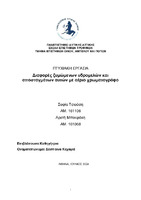| dc.contributor.advisor | Κεχαγιά, Δέσποινα | |
| dc.contributor.author | Τσιούση, Σοφία | |
| dc.contributor.author | Μπεκιράκη, Αρετή | |
| dc.date.accessioned | 2024-09-25T10:04:41Z | |
| dc.date.available | 2024-09-25T10:04:41Z | |
| dc.date.issued | 2024-07 | |
| dc.identifier.uri | https://polynoe.lib.uniwa.gr/xmlui/handle/11400/7469 | |
| dc.identifier.uri | http://dx.doi.org/10.26265/polynoe-7301 | |
| dc.description.abstract | Θέμα της παρούσας πτυχιακής εργασίας είναι να αξιολογήσει με τη βοήθεια της
αέρια χρωματογραφίας τις διαφορές που παρουσιάζουν ζυμώμενα υδρόμελα που
προέρχονται από μέλι διαφορετικών ποικιλιών και τα αποστάγματα αυτών. Για την
παραγωγή των υδρόμελων επιλέχθηκαν 11 διαφορετικές ελληνικές ποικιλίες μελιού
(Παλιούρι Ανθέων, Βανίλια ελάτης, Πεύκο, Πορτοκάλι, Βελανιδιά, Κάστανο, Βαμβάκι,
Πολύκαμπο, Κούμαρο, Λυγαριά, Ρίγανη-Λεβάντα). Η παραγωγή του υδρόμελου
πραγματοποιήθηκε με ζύμωση. Μέλι και νερό αναμίχθηκαν σε κατάλληλη αναλογία
και παρουσία ζυμομυκήτων αφέθηκαν να ζυμώσουν σε συνθήκες περιβάλλοντος.
Μετά το τέλος της αλκοολικής ζύμωσης, μία ποσότητα υδρόμελου αποθηκεύτηκε σε
συνθήκες ψύξης, ενώ μία άλλη ποσότητα οδηγήθηκε για απόσταξη. Λόγω τεχνικών
προβλημάτων η χρήση αέριου χρωματογράφου κρίθηκε αδύνατη. Στην θέση της
πραγματοποιήθηκε οργανοληπτικός έλεγχος των υδρόμελων και των αποσταγμάτων
τους. Αξιολογήθηκαν τα οπτικά, αρωματικά και γευστικά χαρακτηριστικά κάθε
δείγματος. Παρατηρήθηκε ότι η πρώτη ύλη, δηλαδή η ποικιλία του μελιού επηρεάζει
τα οργανοληπτικά χαρακτηριστικά υδρόμελων και αποσταγμάτων. Από τα υδρόμελα
βαθμολογικά προηγήθηκε η Βανίλια ελάτης και το Παλιούρι Ανθέων, ενώ από τα
αποστάγματα η Ρίγανη -Λεβάντα και το Πολύκαμπο. | el |
| dc.format.extent | 103 | el |
| dc.language.iso | el | el |
| dc.publisher | Πανεπιστήμιο Δυτικής Αττικής | el |
| dc.rights | Αναφορά Δημιουργού - Μη Εμπορική Χρήση - Παρόμοια Διανομή 4.0 Διεθνές | * |
| dc.rights | Attribution-NonCommercial-NoDerivatives 4.0 Διεθνές | * |
| dc.rights.uri | http://creativecommons.org/licenses/by-nc-nd/4.0/ | * |
| dc.subject | Μέλι | el |
| dc.subject | Υδρόμελο | el |
| dc.subject | Απόσταγμα υδρόμελου | el |
| dc.subject | Οργανοληπτικός έλεγχος | el |
| dc.title | Διαφορές ζυμώμενων υδρομελών και αποσταγμάτων αυτών με αέριο χρωματογράφο | el |
| dc.title.alternative | Differences of fermented hydromels and spirits with gas chromatograph | el |
| dc.type | Πτυχιακή εργασία | el |
| dc.contributor.committee | Ευαγγέλου, Αλεξάνδρα | |
| dc.contributor.committee | Tataridis, Panagiotis | |
| dc.contributor.faculty | Σχολή Επιστημών Τροφίμων | el |
| dc.contributor.department | Τμήμα Επιστημών Οίνου, Αμπέλου και Ποτών | el |
| dc.description.abstracttranslated | The subject of this thesis is to evaluate with the help of organoleptic control the
differences presented by fermented meads derived from honey of different varieties
and their distillates. For the production of meads, 11 different Greek varieties of honey
were selected (Paliouri Antheon, Vanilla Fir, Pine, Orange, Oak, Chestnut, Cotton,
Polykambo, Koumaro, Lygaria, Oregano-Lavender). The production of mead was
carried out by fermentation. Honey and water were mixed in a suitable proportion and
in the presence of yeasts they were allowed to ferment in ambient conditions. After the
end of the alcoholic fermentation, a quantity of mead was stored in cooling conditions,
while another quantity was sent for distillation. Due to technical problems, the use of
a gas chromatograph was not possible. Instead of gas chromatography, an
organoleptic control of the meads and their spirits was carried out. Organoleptic control
of meads and their distillates was carried out. The visual, aromatic and taste
characteristics of each sample were evaluated. It was observed that the raw material,
i.e. the variety of honey, affects the organoleptic characteristics of meads and spirits.
Among the meads, Vanilia elatis and Paliouri Antheon took the lead, while OreganoLavender and Polykambo were among the spirits. | el |


